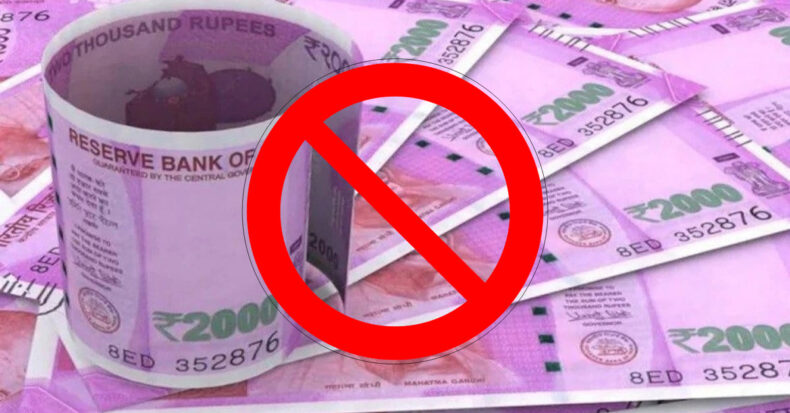In a recent report conducted by SBI Research, the withdrawal of Rs 2000 banknotes from circulation in India has emerged as a potential catalyst for numerous positive macroeconomic effects. Let’s delve deeper into the possible consequences of this significant monetary transition of the demise of Rs 2000 banknotes.
The decision made by the Reserve Bank of India (RBI) is expected to have far-reaching implications, including increased bank deposits, loan repayments, consumption, usage of digital currency, and overall economic growth.

Boosting Consumption Demand:
One of the key anticipated benefits stemming from the withdrawal of Rs 2000 banknotes is the immediate surge in consumption demand. According to the SBI Research report, it is estimated that consumption could receive a frontloaded boost of approximately Rs 55,000 crore. Although the banknotes remain legal tender, it is expected that individuals will redirect their high-value amounts towards purchases such as gold, jewelry, high-end consumer durables like air conditioners and mobile phones, and even real estate acquisitions. Additionally, transactions involving cash value, including energy station payments, cash on delivery purchases, temple donations, and sundry expenses, are projected to witness a noticeable increase.
Increased Bank Deposits:
The removal of Rs 2000 banknotes is likely to result in a significant increase in bank deposits. While some amount may be withdrawn subsequently, the report suggests that Current Account and Savings Account (CASA) deposits may witness a substantial boost of approximately Rs 1.5 lakh crore as a result of this measure.
A noteworthy example is the fortnight ending on June 2, 2024, during which total deposits in All Scheduled Commercial Banks (ASCB) surged by Rs 3.3 lakh crore. By comparing this figure to the average increase in deposits during the same period in the past two years (approximately Rs 1.5 lakh crore), it becomes evident that banks may have received an additional deposit amount of approximately Rs 1.8 lakh crore this year. Such a significant influx of funds can be attributed to corporates choosing to park their surplus liquidity with banks.

Impacts on Credit and Repayments:
As assessed by SBI Research, it is projected that approximately 30% of the deposited amounts (roughly Rs 92,000 crore) might be utilized for loan repayments. Interestingly, credit growth continues to remain strong, signifying the resilience of the Indian economy. This trend indicates that even with frontloaded repayments, the credit sector remains robust and capable of supporting economic expansion.
Overall Economic Growth after The Demise of Rs 2000 Banknotes
The withdrawal of Rs 2000 banknotes is expected to exert broader positive effects on India’s economic growth. By curbing corruption, reducing unaccounted wealth, and promoting digital transactions, this move aligns with the government’s ongoing efforts to formalize the economy and improve transparency. Furthermore, the increased bank deposits and consumption demand are likely to generate multiplier effects, contributing to the overall growth of the country’s Gross Domestic Product (GDP).

Conclusion:
The withdrawal of Rs 2000 banknotes marks a significant turning point for India’s economy. The potential benefits identified by the SBI Research report offer an optimistic outlook for the future. However, it is crucial to approach this transition with careful observation and analysis.
Effective execution of the withdrawal process will be crucial to ensure a smooth transition and minimize any disruptions. The government will need to work hand in hand with the public, providing clear guidelines and assistance throughout the process. Public cooperation and understanding are vital in order to successfully implement the changes and mitigate any challenges that may arise.
Monitoring the real-world impact of this measure is essential. It will allow policymakers to gauge the effectiveness of the withdrawal and make any necessary adjustments along the way. By closely studying the outcomes, policymakers can refine strategies and make informed decisions to drive the economy forward.
Seamlessly managing the transition is paramount. Adequate infrastructure, such as availability of alternative payment options and digital banking services, must be in place to ensure a smooth shift away from the Rs 2000 banknotes. This will facilitate the adoption of digital transactions and minimize any potential disruptions in economic activities.
As the Indian economy continues to evolve, these changes hold great potential for shaping the nation’s economic trajectory. Observing how various sectors adapt and respond to the withdrawal of Rs 2000 banknotes will provide valuable insights into the resilience and adaptability of the economy. Additionally, it presents an opportunity to assess the effectiveness of the government’s efforts in formalizing the economy and promoting transparency.












